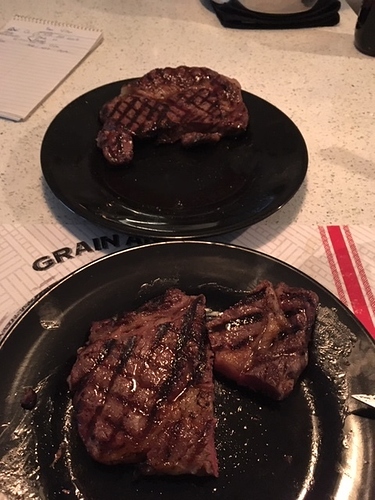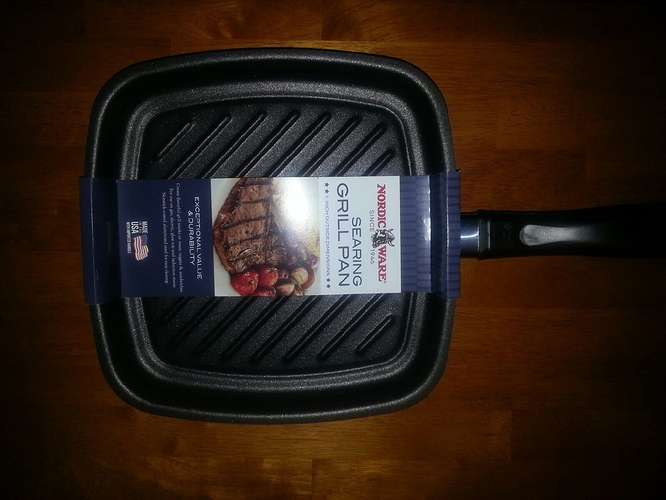That will be the next experiment, since we have natural gas-fired oven.
Searing - What Do You Use?
Dr James DiNicolantonio uses extra virgin olive oil. He says that the antioxidants in it far outweigh/negate any negative impact from the PUFAs if searing at a high heat for a short time as one would post sous vide.
Agreed, Bob. Butter does brown fast in a hot pan - I saw a description of cooking scallops in a pan (which doesn’t take much time at all). No sous vide beforehand. Make sure the scallops are as dry as possible. High heat on the pan, a little olive oil - when it starts to smoke, put in the scallops so they don’t touch each other. 90 seconds on each side. When you flip them over, add some butter - it will brown fast and by the time the second side is done, the butter will have made a nice sauce to pour over the scallops when they’re on the plate.
You know, I’m not a big believer in olive oil or in antioxidants. See this study:
They compared a control diet with diets with corn or olive oil. Which diet was the best? The control. See Table V. By a lot over both corn and olive oil. If olive oil is so great and its antioxidants are so healthy, why this result? And this was as good as it gets, an RCT. No BS epidemiological crap.
And if you look here:
The amount of PUFA in a pound of ribeye steak is 2.69 grams. (This is “separable lean only”, but I can’t find a better version.) If you use two tablespoons of mayo and we’ll assume it’s all olive oil, that’s about 27 grams of oil, about 2.7 grams of PUFAs. You’ve added as much PUFA to your steak as your steak has. (And let’s not even get into the different types of PUFAs.)
Now, is this bad or not? No way to tell. I personally avoid heating olive oil and try to use animal fats like tallow if heated. Though I do use duck fat or pork fat at times, and those are also relatively high in PUFAS. (But I don’t use these for steak.)
It’s just if I can do something else other than heating olive oil, I do it.
Another example of the saying that there is no piece of nutritional information that isn’t contradicted elsewhere. Compound that with my favorite scientific research paper of all time, that up to 70% of published science is wrong. Including itself. Science is in deep trouble - which puts all of us in trouble.
The Olive Oil association and growers will tell you EVO is the best oil to fry in because of its higher smoke point.
(Disclaimer - I’m not coming down on either side. Just showing another view)
I usually use my gas grill. After drying off the sous vide meat I season and oil it up - since I can’t leave it on the grill for long, the oil ups the heat and flame for a quick sear. Lately I have been presearing the meat before sous vide and then freezing the steaks for a quick meal - just thaw, season and eat or throw on the grill for a minute or two.
I’ve done a few eye of round roasts, presearing those, seasoning, adding a little garlic, salt and red wine. Sous vide for at least 24 hours at 131°, drain off the delicious au jus and cool - then thinly slice for French dip. Fabulous!
Last couple rib eyes I did I put on the charcoal,starter chimney after I’d seen this on you tube. Couple hrs sousvide and about 45 seconds then a 45 degree turn. Flip and repeat. Used very little charcoal and it was extremely hot. Perfect just big enough for 2 rib eyes one each for me and the bride.
I recently started using @richard 's Mayo sear, which works fantastic! I also started using just one of my stainless steel pans, instead of the gas grill, which works fine for this. (And my grill is actually quite large to be used for this) But I also picked up a new pan just for this purpose the other day. (Just don’t have the picture of it here with me at work, since I left my cell phone home today) But will post it later.
I do still plan to use the grill from time to time, since I do like the way the fatty ends get nice & crispy. 
Wife saw my post from home and went ahead and sent me the pic of the pan.  … Will probably try it out this weekend to see if it works well.
… Will probably try it out this weekend to see if it works well.
Looks damn good, Thurston. 
I do much the same, lately - although usually with an iron skillet or heavy aluminum-stainless steel or stainless - copper core pan. It doesn’t take very long on each side, and a thicker pan (more thermal mass) is great, I shove the sides of the meat against the sides of the pan, or hold the meat with tongs so the edge of the meat touches the hottest part, giving a little rendering of the fat itself and a nice sizzle right on it.
Couple months old but I’ve since tried ‘Extra Light’ (refined) olive oil - which has a smoke point as high as 470° F or 243° C. It really does make a difference. I fried a london broil last week - right out of the package, no sous vide or anything. This was with just a non-stick electric skillet, which only goes to 400 °/204 °. 7 minutes one side, 6 on the other = perfect. Would go another minute on each side for a really thick ribeye. Oil did not smoke at all, it was just a hot pan with hot oil in it.
London broil is not a particularly tender cut of beef, but it came out beautifully. Yes, probably would have been more tender with a few hours or a lot more hours of sous vide, but it was fine (as opposed to a chuck roast I tried; not fine  ), and I don’t mind chewing some really good-tasting beef once in a while, even crave it from time to time.
), and I don’t mind chewing some really good-tasting beef once in a while, even crave it from time to time.
I think there’s a lot of room here for different methods and personal preference. That cheap electric skillet does a beautiful job on the sear, especially using the sides a good bit.
I’ve been doing that all winter long in the house. I couldn’t sit to get out and use the grill…
What a coincidence that this thread goes active today!
I decided to try to sous vide some chicken thighs (bone in) today. They just went in the bath - it’ll be 160F for 1-1/2 hours. Chill in an ice bath, then sear in some olive oil with some mushrooms and whatever else I can think of. 
Bob, let us know how you find those chicken thighs. I’ve done breasts, and sous vide really shines on poultry, I think - no worries about undercooking it, so no need to overcook it. There is a difference though - I think most of us are used to the meat being somewhat ‘stringy’ - not all that bad a thing, perhaps, but sous vide makes it somewhat different, even versus being cooked to the same temperature.
Will do, Doug. I started out thinking they’d probably be very much like regular thighs because we usually cook thighs to an IT at 165 (except when the oven takes them to 180 IT). Then I started thinking that they hit 165 for a few minutes rather than sitting at 160 for 90 minutes.
That turned it into an interesting experiment.
What temps are being used for poultry? I’ve only used mine for Steaks. Haven’t tried it with chicken yet.
If I’m recalling correctly, there were about six recipes on Serious Eats. All of them were 160 for 90 minutes. (Had to reboot and lost everything that was open) I’ve seen very different temperatures and times for chicken breasts, including down to 140, like you see for pork chops, tenderloin, etc…
They came out of the bath half an hour ago and are in ice water now. Will do the final cooking in about another half hour.
I thought I had heard someone speaking about 160 or so too, but can’t recall? Thanks.
But why do you then go back to ice water. I’ve heard this before too, just never knew what the reasoning for this was?
It’s more obvious with a steak, I think, but the idea is with sous vide you cook the inside and outside separately. You might cook your steak to 133 for the color you want, then you sear the outside for the separate wonderful tastes searing gives.
It’s easier not to let heat penetrate too deeply into the steak if it’s chilled first. If you just took it out of the bag, dried it, and started searing, it’s still close to 133 temperature at the center. As you sear it, heat conducts into the center. Just a few degrees temperature rise can cook the center more than you want. If the center is colder, we’re not talking refrigerator or freezer cold just well under 133, heat conducting in from the outside won’t raise the cooled center’s temperature enough to make it more well-done.
My wife and I both thought it was a success. I chilled the thighs in cool water for close to an hour, then seared them in some bacon grease. We both thought the thighs were more tender than usual, and less stringy as you say, but I don’t think it was a dramatically better, night and day, difference. That might argue for more time at temperature than just 90 minutes.
I thought they were better results than when we broil thighs. I cooked these with skin on and bone in because that’s how we broil them.
We eat chicken thighs more than any other form of meat, so I’ll have plenty of chances to do more experiments.


